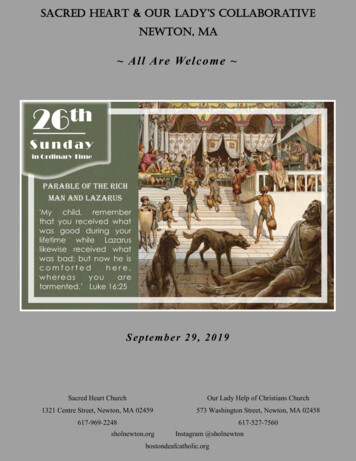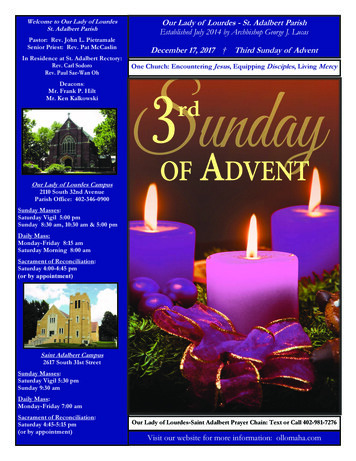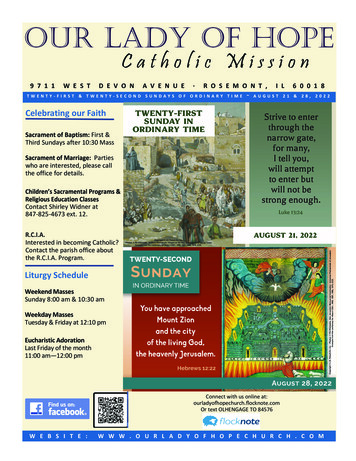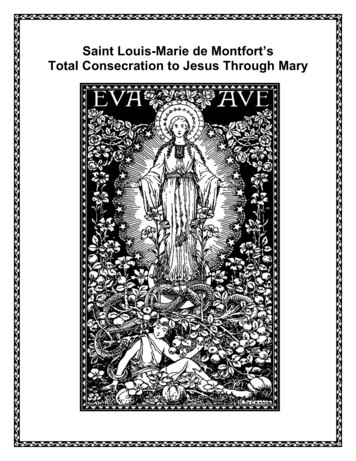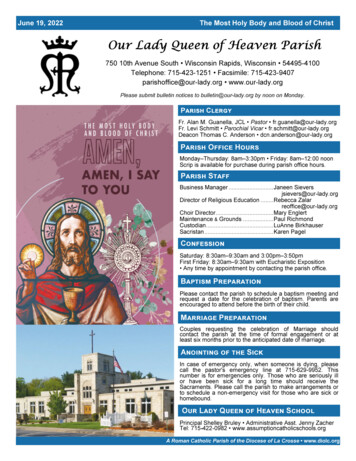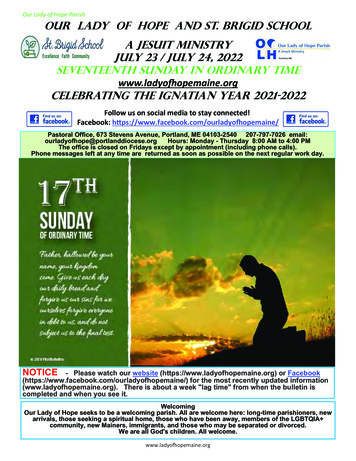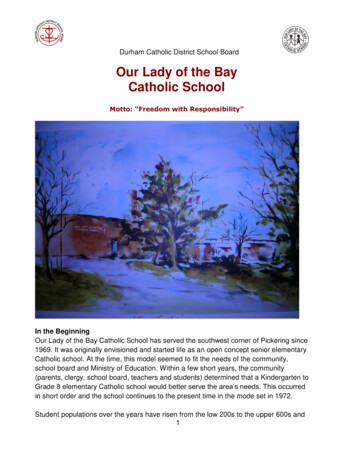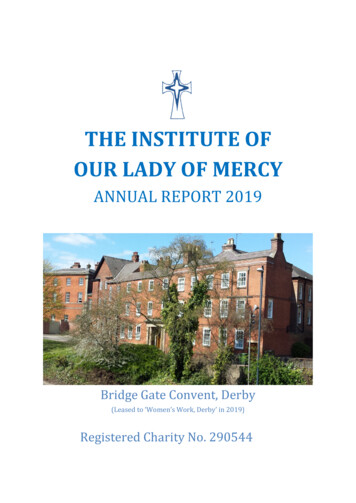
Transcription
THE INSTITUTE OFOUR LADY OF MERCYANNUAL REPORT 2019Bridge Gate Convent, Derby(Leased to ‘Women’s Work, Derby’ in 2019)Registered Charity No. 290544
Annual Reportfor the year ended 31 December 2019ContentsTrustees and Advisers for the year ended 31 December 2019 . .2Report of the Trustees for the year ended 31 December 2019 . .3Independent auditors’ report to the trustees of the Institute of Our Lady of Mercy . .53Statement of financial activities for the year ended 31 December 2019 . .55Charity balance sheet as at 31 December 2019 . . . 56Cash flow statement for the year ended 31 December 2019 . .57Accounting policies .58Notes to the financial statements for the year ended 31 December 2019 .631
Trustees and Advisersfor the year ended 31 December 2019Name of the CharityInstitute of Our Lady of MercyDate of Registration30 November 1984Charity Registration No290544TrusteesNorah Frances CroninJohanna Elizabeth BreenMary Bernadette HolmesBarbara Jane JefferyMary Teresa MullenLynne Julie Spendelow(Sr. Colette Cronin)(Sr. Joan Breen)(Sr. Bernadette Holmes)(Sr. Barbara Jeffery)(Sr Maura Mullen)(Sr. Lyndsay Spendelow)Principal AddressThe GeneralateConvent of MercyCemetery RoadYeadonLeeds LS19 7URProperty AdvisersThe JTS Partnership LLPNumber OneThe DriveGreat WarleyBrentwoodEssex CM13 3DJInvestment AdvisersCharles Stanley & Company Limited25, Luke StreetLondon EC2A 4ARLegal AdvisorsIBB Law LLPCapital Court30, Windsor StreetUxbridgeMiddlesex UB8 1ABPrincipal BankersCo-operative Bank plcP.O. Box 1011, Balloon StreetManchester M60 4EPIndependent AuditorsPricewaterhouseCoopers LLPCentral Square29, Wellington StreetLeeds LS1 4DL2
Institute of Our Lady of MercyReport of the Trusteesfor the year ended 31 December 2019IntroductionThe trustees have pleasure in presenting their report and financial statements for the year ended31 December 2019. The reports and statements are prepared in accordance with Accounting andReporting by Charities: Statement of Recommended Practice applicable to charities preparing theirfinancial statements in accordance with the Financial Reporting Standard applicable in the UK andRepublic of Ireland (FRS 102) (effective 1 January 2015) - (Charities SORP (FRS 102)), theFinancial Reporting Standard applicable in the UK and Republic of Ireland (FRS 102), the CharitiesAct 2011 and with the Charity’s own Trust Deed.The Institute of Our Lady of Mercy is an Order of Roman Catholic Sisters of Mercy (theCongregation). It is one of three strands of the Mercy family in Great Britain, stemming from thefirst foundation of Catherine McAuley. It was formed from the union of twenty autonomousCongregations and was formally recognised by the Vatican as a Religious Congregation ofPontifical Rights in November 1983.The Charity is a charitable trust on which the assets of the Congregation are held and the vehiclethrough which the charitable activities of the Congregation are conducted. The Charity is governedby a Trust Deed dated 24 October 1984 as amended by a Deed of Revocation and Declarationdated 25 June 1992, a Deed of Declaration dated 9 March 2000 and schemes of the CharityCommission dated 9 February 1989, 15 February 1989, 28 July 1995, and 31 December 2000.The Charity is registered with the Charity Commission with registered number 290544. Thetrustees are incorporated under the provisions of Section 251 of the Charities Act 2011 as “TheTrustees of the Institute of Our Lady of Mercy” by a Scheme of the Charity Commission dated 29October 1985.There are two subsidiary charitable trusts, the Fullerton Fund and the Costello Fund (Alnwick) bothof which have specific objects, and which are separately registered with the Charity Commissionas linked charities.Two dormant subsidiary companies, Endsleigh Centre Services Limited and Kinsale Court Limitedwere dissolved on 8 October 2019.The accompanying financial statements relate to the Charity and these charitable trusts.3
Institute of Our Lady of MercySTRUCTURE, GOVERNANCE AND MANAGEMENTThe Appointment of TrusteesThe Congregation is administered by the General Council, which is elected for a five-year term atthe ‘General Chapter’. The Eighth General Chapter took place from 18 – 27 May 2018.General Chapters are held every five years. The Institute Constitutions state that “the supremeauthority in the Institute is vested by the Church in the General Chapter”. Delegates attending theChapter determine the policies and priorities of the Institute. They also elect the Institute Leaderand General Council from those Sisters who are eligible for election. The Institute Leader and themembers of the General Council are, by virtue of clause 6(1) of the Charity’s Trust Deed, alsotrustees of the Charity.The Constitutions of the Congregation dictate that the Institute Leader requires the deliberativevote of the General Council to establish and close houses, acquire or alienate goods or property,and determine such matters as the appointment of Local leaders to Communities and theadmission of members to the Novitiate.The Current Trustee TeamLeft to Right: Sr Lyndsay Spendelow, Sr. Colette Cronin, Sr. Bernadette Holmes,Sr. Joan Breen, Sr. Maura Mullen and Sr. Barbara Jeffery4
Institute of Our Lady of MercyInstitute Leader: Sister Colette CroninSister Colette is a former Secondary School Teacher and holds overall responsibility for theInstitute. She has worked full-time for the Congregation in various roles of responsibility since1987. She is a member of the Mercy International Association (by virtue of being the InstituteLeader) and holds a place on the Board of the Mercy International Association. Sister Colette is aMember of Conference of Religious (CoR) and a Member of the Union International of SuperiorGenerals. She also serves as Governor for two schools: Broughton Hall Catholic High School,Liverpool (a Voluntary Aided school retained by the Institute); and St Joseph’s Park Hill School,Burnley (one of the Institute’s private schools).Assistant Leader: Sister Lyndsay SpendelowSister Lyndsay has a background in teaching at secondary school level and has also worked as aqualified psychotherapist and facilitator. She has previously held roles in Formation Ministry andLeadership within the Institute. Sr Lyndsay was elected as Assistant Leader at the Eighth GeneralChapter and is responsible for Safeguarding. She also holds geographical responsibility for theCommunities in Essex and North London. At the end of August 2019, Sr Lyndsay withdrew fromher roles as Religious Vice Chair of the National Catholic Safeguarding Commission and as amember of the Catholic Council for the Independent Inquiry into Child Sexual Abuse.Sister Joan BreenSister Joan is a former Primary School Head Teacher, who served in both Chadwell Heath, Essexand in Burnley, Lancashire. As a trustee, she holds responsibility for the convents withingeographical area of Derbyshire and South and West Yorkshire – including the ‘Convent withCare’ in Doncaster. She has overall responsibility for Education and serves on the governingbodies of both of the schools that are run by the Institute: St Joseph’s Park Hill School, Burnley,Lancashire; and St Joseph’s Convent School, Wanstead, London E11. Sr Joan supports SrBernadette in her role as lead trustee for Care; is a trustee representative on the EmploymentGroup; and is the trustee responsible for Mercy Associates.Sister Bernadette HolmesSister Bernadette has a nursing background and has focussed on palliative care for much of hercareer. She gained experience at St Catherine’s Hospice Scarborough and was part of the teamthat set up the Macmillan service for Bridlington and East Yorkshire, establishing both theBridlington Macmillan Palliative Care Ward and the Driffield Day Hospice. She previously servedas a trustee of the Institute from 1998 to 2008, where she developed both the Care Homes andConvents with Care. She worked part time for St Gemma’s Hospice Leeds from 2001, moving intooutreach work in deprived areas of Leeds as a palliative nurse specialist from 2004 to 2018. SisterBernadette supports Communities South of London. She links with the Care Homes and staff thatwork with the Institute, in addition to the Formation Group, the Employment Group and the MercyAssociates. Sister Bernadette is also part of the Leeds Diocesan Dementia Project group.Sister Barbara JefferySister Barbara has worked for both the Institute and Union Sisters of Mercy in the field of archivesfor the past 20 years. She held office as the Chair of the Catholic Archives Society andcollaborated on a book on ‘The History of the Diocese of Birmingham (1850-2000)’ when amember of the Diocesan Historical Commission. She also wrote a book on the Hardman Family5
Institute of Our Lady of MercySister Barbara Jeffery (continued)of Birmingham who were instrumental in the Mercy Sisters being established there. She holdsgeographical responsibility for Convents in Wales, Liverpool, Burnley, Newcastle-under-Lyme andHandsworth, Birmingham. She also acted as trustee for St Mary’s Convent Handsworth Charity(Related Party) from 2016 until June 2019.Sister Maura MullenSister Maura is a former Secondary School Teacher. She has held roles previously in Formation,and in Provincial and Central Leadership within the Congregation. She previously served as anInstitute trustee between 1993 and 2003. Sister Maura has also worked in the spheres ofFacilitation and Spirituality offering retreats at St. Beuno’s Spirituality Centre, individual SpiritualDirection and Supervision and as a team member offering training in this field. Sister Maura holdsresponsibility for Formation and relates particularly to Communities in the North East including twoConvents with Care in Hull and Whitby.The Induction and Training of TrusteesAll trustees are members of the Congregation and as such have a comprehensive knowledge ofthe various works and structure of the Charity. They meet with the previous team in order toconduct a comprehensive handover, and also meet with the Institute Advisors.Throughout their term in office, trustees attend formal training courses on the duties of trusteesand seek guidance and advice from their legal, investment, Human Resources and propertyadvisers on the day-to-day issues which arise in carrying out their duties.Organisational StructureThe Organisational Structure Chart can be found on page 8. The trustees conduct the business ofthe Institute at the principal office in Yeadon under the direction of the Institute Leader. They workfull-time for no remuneration.Various roles of responsibility are held by members of the congregation, for example local leaders.Appointments are made for a specific time-period then reviewed. During 2019 one Sister wasappointed and another re-appointed as leader of a local Community. Sister Clare McNamara actsas General Bursar, appointed by the trustees. These members of the Congregation assist thetrustees and attend meetings relevant to their activity.The trustees are also assisted by a small staff team comprising: Business Manager and ExecutiveAssistant to the trustees; Finance Co-ordinator; Human Resources (HR) Co-ordinator; and fourpart-time administration staff. These roles enable the Institute to develop its finance, humanresource, administration and general management functions and provide greater support to itsmembers, staff groups and partner organisations.The Institute Leader holds overall responsibility. The remaining trustees each hold designatedareas of responsibility. All major decisions are made by the group at formal meetings held overthree days in 11 months of the year. (An example would include any specific project expenditureover 2,000).6
Institute of Our Lady of MercyOrganisational Structure (continued)The General Bursar and Finance Co-ordinator attend the meetings relevant to their activity on amonthly basis. The Institute Property Advisors (The JTS Partnership LLP) and Legal advisors (IBBLaw LLP) liaise with trustees and the Staff Team on a regular basis. They submit regular writtenreports and attend meetings on a bi-monthly basis. The Institute’s Auditors(PricewaterhouseCoopers LLP) and Investment Manager (Charles Stanley) attend the meetingson a bi-annual basis.Occasionally, there is a need to make a decision outside of the scheduled meetings. In this case,a quorum of at least three trustees is required to authorise a decision.Separate bi-annual meetings are held with the Institute’s insurers and independent insuranceintermediary (The JTS Partnership LLP).The trustees from time to time appoint Committees to consider particular topics in greater detail.The committees typically include one or more trustees, members of the Congregation, relevantstaff and professional advisers. There are standing committees on employment issues andeducation.The Institute operated two private schools in 2019, each run by an appointed Head Teacher, staffand Board of Governors to whom day to day management is delegated. Sr. Joan Breen serves asa Governor on the Board of both schools. Sr. Colette Cronin serves as a Governor on the Board ofSt Joseph’s Park Hill School, Burnley. (Note: St Joseph’s Convent School for Girls in Wanstead,London was closed in July 2020, see pg. 23).The Institute operated three Care Homes through most of 2019, run by appointed Care HomeManagers. A Clinical Partner and Care Business Partner provide the necessary professionalsupport to the Managers and Staff of the Care Homes. These two part-time consultant roles assistthe trustees in their statutory obligations. (Note: St Mary’s Care Home in Worthing was sold as agoing concern in November 2019, see pg. 31).The CongregationThe Catholic Church requires members of a Religious Congregation to profess three vows:Poverty, Chastity and Obedience. Sisters of Mercy take a fourth vow: ‘to serve the poor, sick andthose in need’ – our ‘Charism’.The Sisters covenant all their personal income to the Charity and live in established communityhouses. Each community budgets for groceries, utilities, vehicle costs and property maintenance.Each Sister is given a small allowance each year in order to allow her a little autonomy and tomanage any personal costs that arise. Extraordinary items such as large-scale propertymaintenance are considered by the General Council and funded centrally.Sisters who are members of the Congregation follow their own Apostolate on behalf of theCongregation: Many Sisters hold (or have held) teaching and nursing posts or perform othervaluable work in the community. At the end of 2019 there were 176 Sisters ministering fromapproximately 50 sites in Britain, Peru, Kenya, South Sudan and Romania.Further information on the activities of our Sisters can be found on pages 35-45.7
Institute of Our Lady of MercyORGANISATIONAL STRUCTURE CHARTAs at December 2019Key: Red Trustee/Leadership Team, Green: Generalate Team, Blue: Communities, Purple: Care Homes,Brown: SchoolsMercy AssociatesThere are various groups of Mercy Associates throughout the UK consisting of Sisters, lay menand women and young people. These groups study the life of Catherine McAuley and are imbuedwith the Charism of Mercy. They pray together and carry out works of Mercy.The Mercy Associate National Commission was set up in 2000. Some Institute Sisters serve onthe Commission, together with Sisters from the other Mercy Groups and several lay people.Some Mercy Associate groups begun by Sisters are now continuing on their own when conventshave closed, or Sisters have moved away. These groups maintain their links to the NationalCommission and take part in national and local events.8
Institute of Our Lady of MercyEmployeesThe Institute recognises that staff lie at the heart of its mission and charitable work. The work ofstaff directly supports both beneficiaries and the welfare of the Sisters. In the past, Sisters andstaff have worked very closely together, for example in schools and care homes. As this is nolonger possible with an aging Sister profile, the Institute looks to provide the necessary vision andsupport for staff in fresh ways. Many Sisters sit alongside staff on management teams overseeingoperational elements of the Institute’s work, for example in the Institute’s governance, in carehomes, in schools and in employment matters. The sharing of this Mercy ethos and charism withstaff continues formally and informally through building supportive relationships and demonstratingpastoral concern for all our staff whatever their role or location. The sharing of Mercy wisdom andexperience from the Sisters is a hallmark of the Institute’s support to all its valued staff.As at the end of 2019, the Charity had 282 employees, equating to 214 full time equivalents(FTE’s) (full time being 35 hours). A breakdown of employee numbers is given in the table below:Staff NumbersPercentageFTEFTEPercentageCare Homes11039%9846%Convents hools5118%3818%Other93%73%Total Employees282100%214100%Across the Institute, the purpose of FTEs can be classified as follows:Role PurposeFTEFTE 7%Maintenance126%Total214100%(Note: With the exception of administration and maintenance staff; those employed within CareHomes and Convents have been classified as “Care”; those employed within schools areclassified as “Education”).9
Institute of Our Lady of MercyPay PolicyThe Institute continues to develop its approach to remuneration.The Institute aims to pay competitive rates of pay to attract and retain staff who possess the skillsand talents needed to deliver our charitable aims and objectives. Careful consideration is made ofaffordability, current market rates, business plans and the relationship between job responsibilityand pay. The Institute strives to ensure responsible use of resources alongside the desire to be anattractive employer of choice in our sector.All staff employed outside of London were paid at least the ‘real living wage’ and the Institutecontinues to work towards implementing this for London based staff.The wider ‘employment offer’ at the Institute includes a staff benefits scheme to help reduce thecost of daily living expenses, increased holiday entitlements, a cycle to work scheme, discountedgym membership and a comprehensive employee assistance programme including health andwellbeing. Staff also benefit from many personal development opportunities appropriate to theirrole.10
Institute of Our Lady of MercyGender Pay Gap StatementFrom April 2017, Gender pay reporting legislation requires employers with 250 or more employeesto publish statutory calculations every year, showing the difference between the average earningsof all men and all women.Mirroring the rest of the Care sector where most of our staff are engaged, the Institute employssignificantly more women than men. At the reporting date of 5 April 2019, we employed 325people. 89.2% of these were women and 10.8% were men. This is a 2% increase of female stafffrom 2018.The Institute is publishing the results of six calculations using hourly pay rates as at 5th April 2019.These calculations do not reveal individual salary information.Median gender pay gap in hourly payThe data shows that on average the Institute pays women 2.52% more than men, resulting in anegative gender pay gap. There has been a 5.52% increase in the median rate of pay for womenbetween 2018 and 2019.Mean gender pay gap in hourly payThe data shows that on average the Institute pays women 4.52% more than men, resulting in anegative gender pay gap. There has been a 6.52% increase in the mean rate of pay for womenbetween 2018 and 2019.The median and mean gender pay calculations both show that on average female staff havehigher pay then male staff. This is due to the larger proportion of female staff in higher paidmanagement roles in the Institute.Bonus PaymentsWhile the Institute of Our Lady of Mercy does not pay bonuses to staff, one exceptional paymentwas made in the reporting period as follows: percentage payment made to males 0%, percentage11
Institute of Our Lady of MercyGender Pay Gap Statement (continued)Bonus Payments (continued)payment made to females 0.3%. Due to the very small percentage involved this resulted in both a0% median and 0% mean average bonus payment.Equal PayIt is important to note that a gender pay gap is different to equal pay. Unequal pay is unlawful, andwhile a gender pay gap is not unlawful it is something to review and address. There can be manycauses of a gender pay gap, some of which are not in the control of an employer. Further analysison the Institute gender pay gap figures is provided below.Equal pay deals with the pay differences between men and women who carry out the same roles,similar jobs or work of equal value. The Institute strives to ensure that our rates of pay ensureequality for both men and women carrying out work of equal value.Proportion of males and females in each pay quartileWe can better understand the gender pay gap when we analyse all male and female roles acrossthe Institute and divide them into four pay bands. The lowest rates of pay are in the first quartileand the highest in the fourth quartile.2019First QuartileSecond QuartileThird QuartileFourth QuartileMen13%10%10%11%Women87%90%90%89%For comparison purposes, the 2017 and 2018 data are given below.2018First QuartileSecond QuartileThird QuartileFourth QuartileMen8%12%16%14%Women92%88%84%86%12
Institute of Our Lady of MercyGender Pay Gap Statement (continued)Proportion of males and females in each pay quartile (continued)2017First QuartileSecond QuartileThird QuartileFourth QuartileMen8%8%15%19%Women92%92%85%81%While the 2019 pay quartiles continue to show a high proportion of female staff across the full payrange, there has been a noticeable increase in the number of female staff across the second, thirdand fourth quartiles compared to the 2018 data. This positive increase in the higher pay rates anda lower representation in the lowest quarter has been a significant factor in generating a negativegap (where women are paid more than men) than the previous positive gender pay gap (wheremen are paid more than women).Commitment to equality and good employmentWe are pleased that the Institute’s gender pay gap has reduced significantly in the last year as aresult of the actions taken.Our reported small negative pay gap (where on average women get paid more than men) is areverse of the wider picture where the national median average is 8.9%* for full time employeesand 17.3%* for all employees. Not being complacent, the Institute remains fully committed toworking towards our target of having a zero gender pay gap. We set out below some of thestrategies we are using to achieve this aim.Our thorough review of pay rates continued in the second half of 2019 with gender pay gapconsiderations incorporated into the pay review process alongside those at the point ofrecruitment. We continued to ensure that roles which had previously been undervalued receivedincreases which provide pay equality in future years.Career development opportunities are available to all staff irrespective of whether they work fulltime or part time. Similarly, the Institute reiterates its commitment to encouraging employees totake advantage of the many opportunities to undertake professional development, which isavailable at all levels and in all roles. Where possible, training is offered at different times to meetthe needs of part time staff.Where business needs allow, the Institute supports all staff who have caring responsibilities byoffering various work patterns, job sharing opportunities and shared parental leave.In relation to recruitment, the Institute considers offering senior roles on a part time basis and willcontinue to review its recruitment processes to further reduce the possibility of unconscious biaswith additional training in this important area. We require recruiting managers to analyse all newroles to help ensure that good job design and equitable reward is considered at the earliest stageof the recruitment process. We provide clear rates of pay to all job candidates.We remain committed to removing any unnecessary barriers in our desire to be a fair employer,rewarding staff irrespective of gender or identity.13
Institute of Our Lady of MercySAFEGUARDINGInstitute Safeguarding Policy StatementThe Institute of Our Lady of Mercy is committed to the national safeguarding policies of theCatholic Church in England and Wales, to take all reasonable steps to protect all who arevulnerable from any form of abuse and to promote a safe environment for them.This commitment flows from the fact that we are all made in the image and likeness of Godand the Church's common belief in the dignity and uniqueness of every human life. We startfrom the principle that each child, young person and adult at risk has a right to expect thehighest level of care and protection, love, encouragement and respect that we can give.The Institute will liaise closely and openly with statutory agencies to ensure that anyconcerns or allegations of abuse are promptly reported and appropriately dealt with, victimssupported, and perpetrators held to account.Our expectation is that this statement will be accepted and upheld by our Sisters andAssociates, Staff, Volunteers and all who work for and with us in the Institute and also thosewho use our premises.As part of the Roman Catholic Church in England and Wales, the Institute of Our Lady of Mercyupholds the common commitment to safeguarding as an integral part of the life and ministry of allits members. This is reflected in the Institute’s affirmation of the ‘One Church’ approach tosafeguarding children, young people and adults who may be at risk. The ‘One Church’ approachrefers to the commitment by members of the Church to adhere to the same national safeguardingpolicies and procedures of the Catholic Church in England and Wales which can be seen atwww.csas.uk.net/procedures. The Institute’s Safeguarding Policy is compliant with these nationalpolicies and procedures.The responsibilities of the Leadership Team (trustees), Safeguarding Coordinator, each memberof the Institute, employees and volunteers are referred to in this document. The Institute hasmeasures in place to ensure that all employees and volunteers (which includes Sisters) have DBSclearance as required by their roles.The Institute Safeguarding Commission (including external professionals) works with dedication tosupport and oversee implementation of the policy. Recruitment of new members to theSafeguarding Commission has taken place since the last Report.The Institute has responded to any requests for information from the Catholic SafeguardingAdvisory Service (CSAS) or the Conference for Religious (CoR) to assist the work of theIndependent Inquiry for Child Sexual Abuse (IICSA), seeking always to be transparent in itshandling of safeguarding issues.14
Institute of Our Lady of MercyExternal Safeguarding LinksSister Clare Smith, the Institute’s Safeguarding Coordinator, attends meetings of the NationalCatholic Safeguarding Coordinators and is a member of the Executive Advisory SafeguardingGroup (EASG). The EASG advises the Executive of the Conference of Religious (CoR) onSafeguarding matters and helps to maintain standards and links within Catholic Safeguarding,offering informal support to other religious orders. Sr Clare has been the Religious representativeon the Hallam Diocese Safeguarding Commission for over five years.Having been elected as Assistant Congregational Leader at the Institute’s General Chapter in May2018, Sister Lyndsay Spendelow withdrew from her roles as Religious Vice Chair of the NationalCatholic Safeguarding Commission (NCSC), membership of the EASG and also as CoRrepresentative on the Catholic Council for the Independent Inquiry into Child Sexual Abuse(CCIICSA) at the end of August 2019.In support of the work of the CCIICSA, the Institute made a prior year donation of 50,000 to theCatholic Trust for England and Wales in response to a request for all Congregations to try to assistwith financing the legal costs of the CCIICSA. No donation was made in 2019.15
Institute of Our Lady of MercyRelated PartiesThe Charity works closely with the following charitable organisations, having been involved in theirformation:Mercy Great Britain CIO (Registered Charity No.1154195)Mercy Great Britain CIO raises funds for the Mercy International Association. The MercyInternational Centre, based at the original Convent of Mercy in Baggot Street, Dublin, is the focalpoint for all Sisters of Mercy throughout the world.As stated previously, Sr. Colette Cronin is a member of the Mercy International Association byvirtue of being the Institute Leader. She also holds a place on the Board of the Mercy InternationalAssociation.No funds were donated to the charity in 2019 (2018: nil).Women@TheWell (W@W, Registered Charity No. 1118613)The Women@TheWell Charity was established by the Institute of Our Lady of Mercy in 2006. Thecharity provides services to vulnerable women trapped in multiple cycles of abuse and socialexclusion. Services are provided for women by women in a supportive environment with the goalsof diverting them from the criminal justice system and working towards meaningful and rewardingsocial participation.The Institute of Our Lady of Mercy has the right to appoint two trustees of Women@TheWell. In2019 the following members of the Institute served as trustees for Women@TheWell: Sr AnneHewitt, Sr Esther Boles and Sr Jude Groden (who retired in December 2019). The CEO ofWomen@TheWell, Sr. Lynda Dearlove, is a member of the Institute of Our Lady of Mercy. Thr
Sister Colette is a former Secondary School Teacher and holds overall responsibility for the . Sister Bernadette has a nursing background and has focussed on palliative care for much of her career. She gained experience at St Catherine's Hospice Scarborough and was part of the team that set up the Macmillan service for Bridlington and East .


